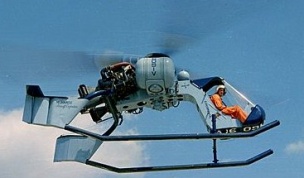
""
MC.
DONNELL
Mc DONNELL 120 |


|
|
|
La
compañía McDonnell decide en 1956 embarcarse en una aventura privada
al desarrolar y testear un pequeño helicóptero tipo grúa de una sola
plaza utilizando el rotor del McDonnell XV-1. La maqueta
del Model 120, el cual fue diseñado por un equipo liderado por
el Ingeniero Lloyd R. Novak, fue completada en enero de 1957, y el
primero (N6081V) de dos prototipos voló el 13 de noviembre de ese año
piloteado por John R. Noll. Este helicóptero era de un diseño simple,
con el piloto sentado centralmente y los tanques de combustible a cada
lado del fuselaje en la parte superior, cercanos a la cabeza del rotor.
Tres turbinas compresoras AiResearch GTC-85-135 alimentaban a los jets
ubicados en las punteras de las tres palas del rotor principal. Un tren
de aterrizaje bastante ancho le permitía el izado de grandes cargas o
también se había previsto un compartimiento especial para poder
transportar hasta 12 soldados o equipo contra fuego o containers de
carga. A pesar de
algunos problemas con las plantas de poder, el Model 120 demostró
una capacidad de carga bastante buena, pero desafortunadamente permaneció
en la etapa experimental al no poder McDonnell ganar ninguna orden, ni
civil ni militar para este competente diseño. El programa finalizó en
febrero de 1960. |
|
|
|
McDonnell decided in December 1956 to undertake as a
private venture the design, development, and testing of a small
single-seat crane helicopter using the XV-1 rotor. The mock-up of the Model 120, which was designed
by a team led by Project Engineer Lloyd R. Novak, was completed in
January 1957, and the first (N6081V) of two prototypes was flown on 13
November of that year by John R. Noll. This helicopter was of simple
design, with the pilot seated centrally and the fuel tanks mounted on
each side of the upper fuselage beneath the rotor head. Three AiResearch
GTC-85-135 gas-turbine compressors, which fed pressure jets at the tips
of the three-blade rotor, were located below and behind the rotor head.
A wide-spaced skid undercarriage enabled large loads to be slung beneath
the centre of gravity, or specialized pods to be fitted to carry up to
12 troops, firefighting equipment, or cargo containers. In spite of some powerplant teething problems, the Model 120 demonstrated a maximum load-to-weight ratio of 1.5:1. Unfortunately, in spite of having been judged 'one of the most outstanding helicopters evaluated to-date in its weight class' when flown at the Naval Air Test Center, NAS Patuxent River, in September 1959, the Model 120 remained experimental as McDonnell failed to win either military or civil orders for this competent design. The termination of this programme in February 1960 marked the end of McDonnell's independent efforts in this field as 13 months earlier the US Marine Corps had terminated the development of the XHCH-1 crane helicopter. McDonnell Douglas, however, came back to the helicopter field in 1984 with its acquisition of Hughes Helicopters, Inc. |
|
|
|
Characteristics |
Information |
Characteristics |
Information |
| First
Flight Primer Vuelo |
1957 |
Engine Motor |
3 AiResearch GTC-85-135 gas-turbine compressor |
| Seating
Capacity Plazas |
1 |
Power Potencia |
shp T.Off |
| Empty
Weight Peso Vacío |
1110 Kg |
Hover
Ceiling O.G.E. Estacionario O.G.E |
Mt |
| Maximum
Weight Peso Máximo |
2268 Kg |
Hover
Ceiling I.G.E. Estacionario I.G.E |
3660 Mt |
| Vel.
Cruise Vel. crucero |
95 Kts |
Service
Ceiling Techo de Servicio |
Mt |
| V.N.E. V.N.E |
120 Kts |
Maximum
Range (Std) Alcance (Std) |
85 NM |
|
Dimensions / Dimensiones |
|||
| Total
Length Largo Total |
20,0 Ft |
Main
Rotor Diameter Diam. Rotor Principal |
31,0 Ft |
| Total
Height Alto Total |
8,98 Ft |
Tail
Rotor Diameter Diam. Rotor de Cola |
NA |
Copyright © 1999 / 2003